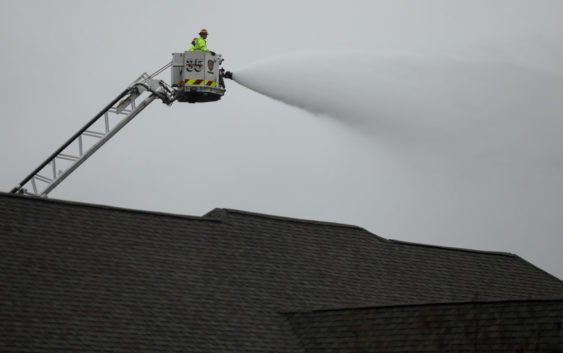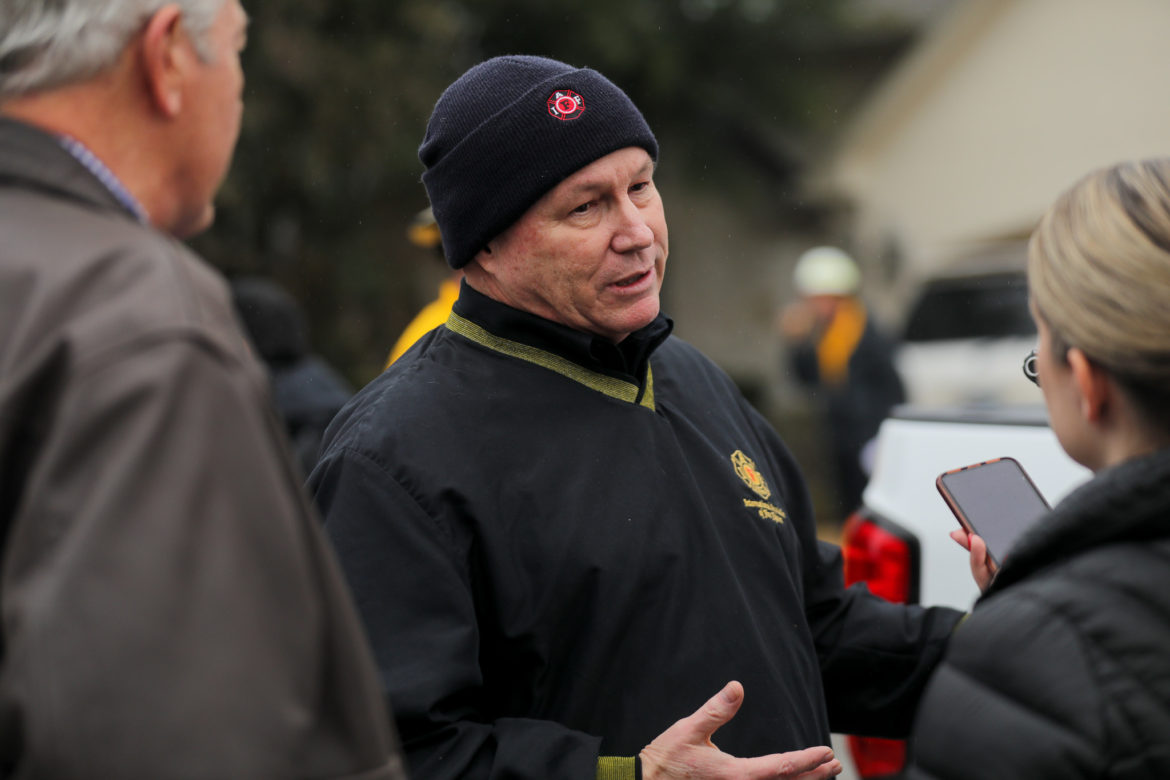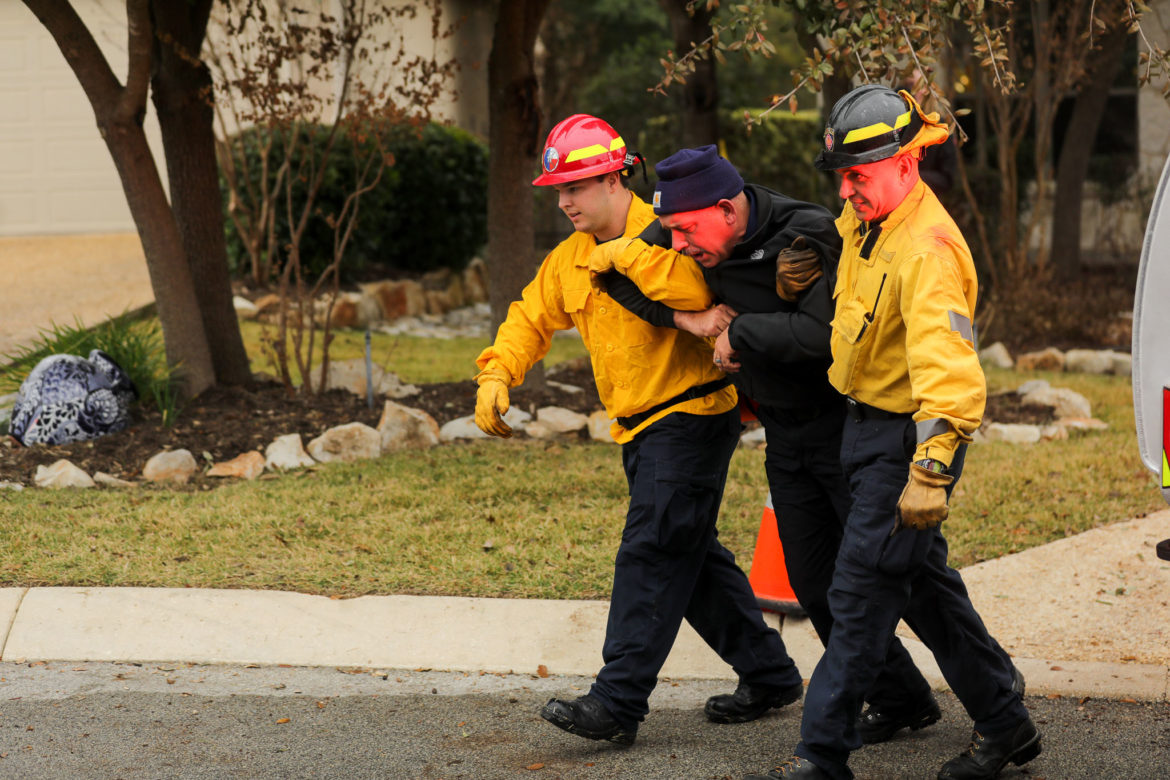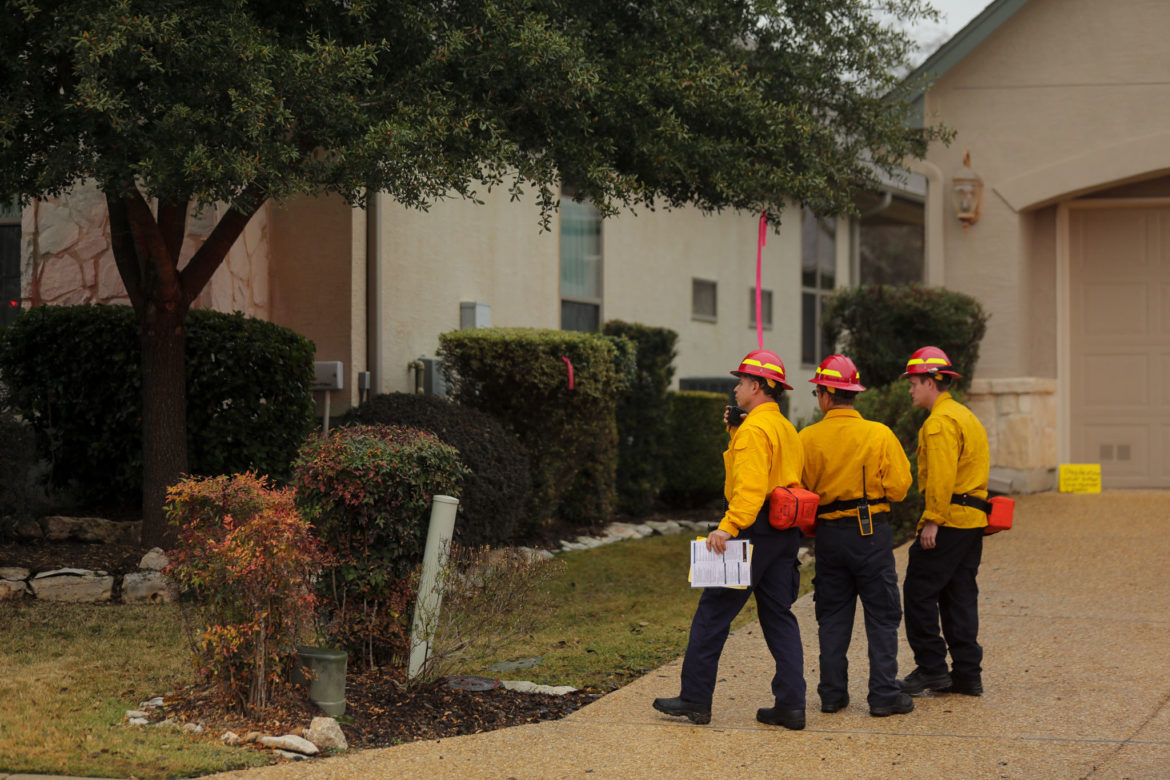- Seven months after Hurricane Helene, Chimney Rock rebuilds with resilience
- Wildfire in New Jersey Pine Barrens expected to grow before it’s contained, officials say
- Storm damage forces recovery efforts in Lancaster, Chester counties
- Evacuation orders lifted as fast-moving New Jersey wildfire burns
- Heartbreak for NC resident as wildfire reduces lifetime home to ashes
San Antonio’s Big Wildfire Is Coming, Here’s How Firefighters and Communities Are Preparing

Fog and mist enveloped the Roseheart subdivision nestled in the thick brush of northern Bexar County on December sixth, as firefighters gathered there to train for the kind of wildfire that could turn the neighborhood into a roaring inferno.
Firefighters in full gear ran between houses and into backyards, some dragging hoses behind them, simulating real-life fire scenarios. Instructors came to the training event from around the country, including from California, where historic wildfires raged across part of the state in November.
The training was in preparation for an event that hasn’t happened yet in San Antonio: a massive wildfire that destroys dozens of homes and requires whole neighborhoods to be evacuated.
“Everyone’s seen the massive fires that were fought in California over the last month,” San Antonio Fire Chief Charles Hood told the media during the training event. “We have some of those same dynamics as far as the fuel load, as far as the topography. We have continued to build out into wildland spaces.”
Hood was describing conditions that make the northern reaches of San Antonio are among the most at-risk for destructive wildfires in Texas, according to Texas A&M Forest Service data.
In the open lands around San Antonio, wild spaces are filled with brush and vegetation that often builds up during rainy years before dying and drying during droughts.
Before European settlement, natural wildfires once swept across the region, cutting back on this growth. But centuries of fire suppression have caused a buildup of fuels that are often just waiting for a spark.
Scott Ball / Rivard Report
Water is sprayed into the backyard of a suburban home to avoid the bordering dense brush from becoming fuel for a wildfire.
In fact, the San Antonio Fire Department is already battling fires in open areas on a regular basis. In 2018 alone, firefighters responded to 1,128 reports of brush or grass fires through Dec. 12, officials said. That doesn’t even include fires that start along roads and highways.
Despite the frequency of low-level brush fires, massive wildfires have not been common in San Antonio. The region’s most famous blaze involved an eight-story pile of brush and debris that started smoldering in Helotes in 2007. It earned the nickname “Mulchie.”
In 2017, firefighters had prepared an evacuation plan for the Dominion, a wealthy gated neighborhood off Interstate 10 West, after a fire broke out on the adjacent Camp Bullis. Firefighters were able to contain the blaze on-base.
But the big fire is coming, experts warn. Rick Swan, a more than 30-year veteran of the California Department of Forestry and Fire Protection who was in San Antonio for the training, said as much after seeing the brush and forested land around parts of Bexar County.
“It’s a matter of time, weather, and a moment,” Swan said.

Scott Ball / Rivard Report
Veteran firefighter Rick Swan speaks to reporters about the risks of fast-moving wildfires.
During the past few days, even after last weekend’s rain, the weather changed enough to raise fire risks around San Antonio. On Thursday, the National Weather Service issued a fire warning for much of South Central Texas, with high winds and low relative humidity making fires likely to spread.
“Although we have had some wet weather, this has caused an abundance of grass and woody growth,” Bexar County Fire Marshal Chris Lopez said in a statement. “The recent freezing temperatures have killed this growth and turned them into fuel sources for fire.”
Local conditions like these make it all the more critical to prepare, Hood said. The training program being tested in San Antonio, developed by the International Association of Firefighters, is meant to give firefighters trained to battle blazes in homes and buildings the skills to fight wildland fires.
“It’s completely different,” Hood said, explaining that structure fires are more controlled, while fires near open country may require firefighters to pull back and only save what they can.
“I might have to pull back and find an area that I can safely cut this fire off because I don’t have the resources right then to take care of this massive fire,” Hood said.
Swan now works with the International Association of Firefighters to develop wildland firefighter training programs. He and others are also testing the training in Colorado Springs, Colorado, and Lewiston, Maine, he said.
The techniques he’s teaching are all about speed and efficiency. For example, instead of putting hoses back neatly on a fire truck as they’ve been trained to do during structure fires, firefighters fighting a wildland fire should throw it back on the truck as quickly as possible to move onto the next house, even if it looks a bit messy.
“They’re not used to doing this; that’s not how they’re trained,” Swan said. “We want to break that muscle memory.”

Scott Ball / Rivard Report
Firefighters aid a pedestrian during a simulated medical emergency involving smoke inhalation from nearby wildfires.
The training involved 60 San Antonio firefighters who completed 25 hours of online curriculum and eight hours in the classroom, Swan said, followed by the training drills at Roseheart. Those who complete it can go on to train other firefighters in the department.
But it’s not only firefighters who should take responsibility for wildfires. Homeowners also can do their part to prepare, according to Tom Jones, a Roseheart resident and chair of the community’s Firewise committee.
“This is almost like an island of wilderness in the middle of the city,” Jones said of his subdivision. “We’ve got wildlife all around us. It’s great, it’s beautiful, everybody enjoys it. But there’s also fuel when it dries up. So if it ever ignites, we obviously want to give the fire department an opportunity to have a first line of defense to keep it from ever encroaching on the neighborhood.”

Scott Ball / Rivard Report
Firefighters survey a scene during the simulated training session.
Firewise, an initiative by the National Fire Protection Association, helps prepare communities for wildfire. At Roseheart, one of the most important developments it led to was cutting out the undergrowth surrounding a walking trail that circles the subdivision.
The area now serves as a “shaded fuel break” that gives firefighters an extra edge on a wildfire as it approaches the community, Jones said. It serves its purpose without creating an ugly stretch of clear-cut trees, Fire Department Capt. Jarrett Vocke said.
“It’s a great situation because it doesn’t hurt the aesthetics of the neighborhood,” Vocke said. “It actually improves them.”
Jones said he and his neighbors decided to implement the measures after speaking with firefighters at the nearest station. They realized that even though firefighters are prepared for wildfire, the station only has three brush trucks that could be on the scene immediately.
“Are they only going to save three houses?” Jones said. “You realize that these techniques … triaging which houses are already past saving and which houses are likely to be saved makes a lot of sense.”
Roseheart is one of only six communities in Bexar County the National Fire Protection Association lists as Firewise. The others are Shavano Park, Leon Valley, Iron Horse Canyon, Los Reyes Canyons, and Big Springs.